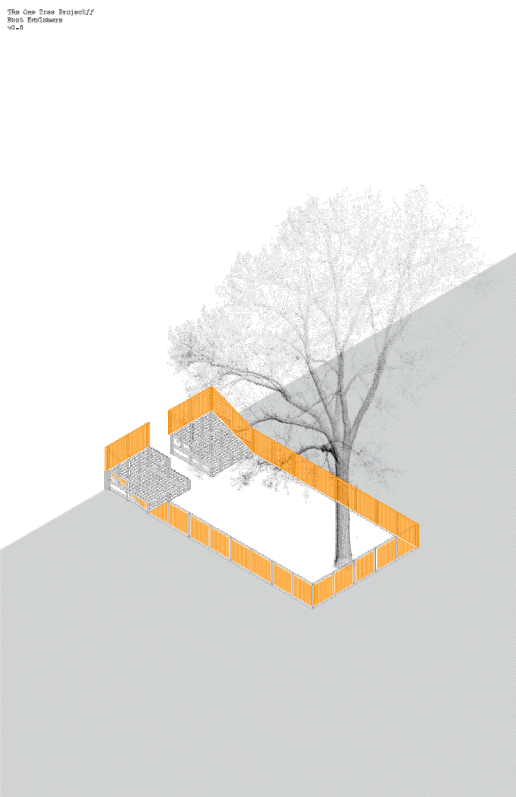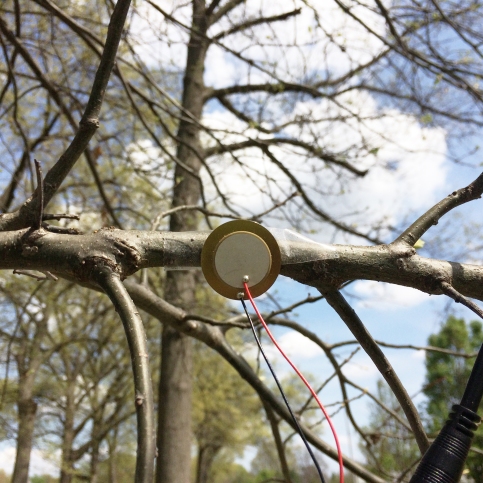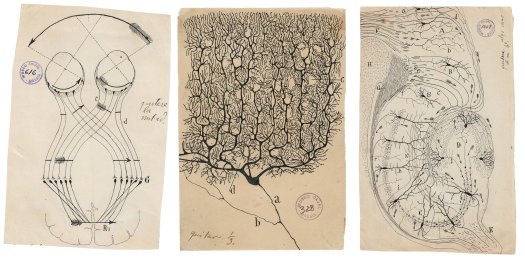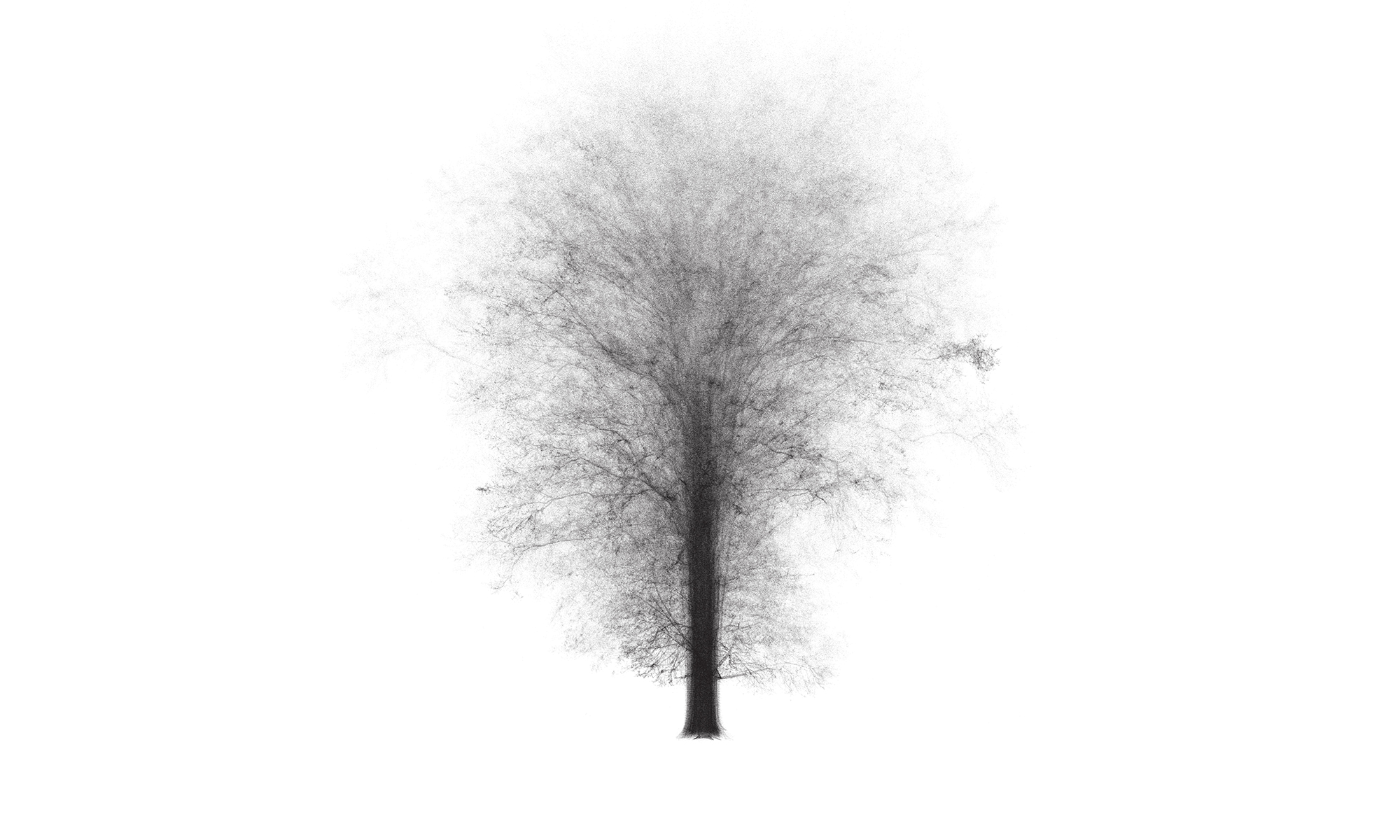This recording is a result of embedding two contact microphones into either side of a tree trunk as the tree is cut down.
Tree Listening
The tree quartet imagines four trees roughly situated at four corners of a piece of the allee as receivers, transmitters, conduits for sound. The trees listen, they perform, they are performed by people, wind, birds. Each tree is equipped with a contact microphone and a guitar amplifier situated to create a space which gathers the four trees and begins to depict the soundscape of the trees as individual attentive bodies and the allee as a collective array of antennae. (recording by Jesse Vogler)

Worm’s Eye View
The second iteration of our root/tree enclosure has been in place for several weeks and has seen more use than the first. Perhaps this is due to the increasingly warmer and sunnier spring weather? Perhaps it has something also to do with the configuration of the enclosure itself? A series of drawings for each iteration of the enclosure provides further opportunities to consider what it means to create an interior and exterior space, what it means to position ourselves in relationship to the tree. Critical to this analysis is the point of view of the drawing. Four drawings for each enclosure were made, all done in parallel (isometric) projection, however the most compelling point of view in my mind, was the worm’s eye view.


This point of view seems appropriate for the enclosures because it positions the observer looking upward into the tree, as you would be if you were seated in the enclosure itself. It also strengthens, lengthens and underscores the tree and the enclosure, and their presence, while humbling the viewer. The worm’s eye view offers a sensation of being embedded within the earth looking through transparent soil to the tree and the enclosure above. Perhaps root’s eye view is more appropriate for the context of our studio? At least one more set of drawings to add to the current two would make a more complete series, so I am thinking about the next iteration of our enclosure project and what that might look like…
Tree Listening
Another set of tests with listening to the trees today, this time using simpler microphones – two 27mm piezo discs (acoustic pickups). The simplicity of their design offers other possibilities for connecting them to the trees. I tried two different configurations today; slotting them into spaces between the bark, and adhering them to a branch with two-sided tape. Having two of these microphones also allowed for recording in “stereo.” I inserted the microphones into the tree one on either side of one of our boreholes and began speaking into, blowing into, and prodding the borehole. (it’s best to listen to these files with headphones)

I also tried adhering the microphones to two locations on one low-hanging branch. The left channel (ear) microphone was placed closest to the trunk and the right channel (ear) microphone was placed further out along the branch. I then began repeatedly bending the branch.

The second recording marks a significant step in the tree listening experiments. Rather than generating a sound with an external device and recording that sound as it travels through the tree, the recording of the branch bending is the sound of the tree itself as it responds to an external stress. The result is much richer and the difference in location of the microphones is audibly detected. There is evidence to suggest that smaller plants (and perhaps trees?) produce an immediate electrical response when subjected to stresses such as having a leaf torn, or having stems shaken. If this holds for our oak trees, capturing that electrical variation and feeding it through audible output (vocoder, MIDI controller) might be one way to give a voice to the trees.
Listening to a Tree
Provoked by questions surrounding the nature of sound in/through/among trees, we completed our first auditory exploration on tree C7 in the allee. Carefully working through the layers of bark until we encountered the living matter of the tree, we carved a 4 inch square hollow in which to place our listening device. This device is an ElectroVoice Model 805 Crystal Contact Microphone, circa 1950 (incidentally and coincidentally,this exact model of microphone has apparently been used on trees before to record beetle movement!).

The first tests frame the tree as a resonator, planting the microphone within the hollow and recording the output with a zoom mic. Using a mallet on the bark we circumscribed the tree with a series of taps moving first away from the mic and returning to it from the other side. This exercise produces a few new ways in which to draw/diagram the tree. The recorded audio itself (with some simple noise reduction applied) places us in the sonic space of the tree. The spectral frequency of this recording also allows us to understand the tree in a new way.

What does the attack, decay, sustain, release profile of these mallet strikes tell us? Can the heartwood be read from the signal? Or does the variation simply indicate the difficulty in maintaining a consistent signal from point to point? Thirdly, the dance around the tree with the mallet serves as a diagram. Certainly much more can be mined from this first test. The next step will be to frame the tree as an articulator, listening for the sounds the tree itself produces, especially as it begins to wake from it’s winter slumber.
The Log Driver’s Waltz

A little bit of tree culture, this short animation developed by the National Film Board of Canada was used often as filler between television programs when I was growing up. The Log Driver’s Waltz puts a romantic spin on Canada’s long history in the logging industry. As a kid I used to love when this would come on.
Chimeric Sensing

The term chimera is used to describe organisms composed of cells which originate from two or more distinct genetic genealogies. It has been suggested that the cilia which facilitate the human senses may be “chimeric compounds of once free-living organism, now yoked together in our animal bodies and harnessed to enable sensory apprehension” (Helmreich 2016, 175) implying that we ourselves are chimeric organisms. If this is so, can some of our genetic lineage be traced back to trees, also considered chimeric organisms? And what are the chimeric compounds with which trees sense the world? Beyond this biological chimerism there also exists a technique called auditory chimerism a tactic used to decompose and reconstruct sound recordings “realized through a technical practice of sieving one sound through the other—pressing the ‘fine structure’ (the second-to-second pitch and texture) of one sound (say, a drum) through the ‘envelope’ (overall attack, sustain, and decay profile) of another (say, a piano).” (Helmreich 2016, 174).
Timbre also plays an important role in the study of auditory chimerism. It is described as “that attribute of auditory sensation in terms of which a listener can judge two sounds similarly presented and having the same loudness and pitch as being dissimilar.” (Helmreich 2016, 176). There might then be two ways to explore trees in terms of sound. As articulators (producing sounds of their own) and as resonators (instruments to be played). If we were to record the sounds emanating from the trees and recognize dissimilarity in these sounds across different trees or different species of tree, perhaps a taxonomy of tree sound could be established, suggesting the idea of a timber timbre. And applying techniques of auditory chimerism, passing the fine structure of tree sound through the envelope of human speech (and vice versa), could be one way of exploring a biological chimerism that speaks to other relationships between people and trees.
Helmreich, Stefan. 2016. Sounding the Limits of Life: Essays in the Anthropology of Biology and Beyond. New Jersey: Princeton University Press.
Klein, Joanna. 2017. “Hunched Over a Microscope, He Sketched the Secrets of How the Brain Works.” New York Times, February 17.
Root Excavation – Day 04

As our unearthing of the root continues and we contend with grafts, elbows, changes in pitch, and buried infrastructure (!), we are also grappling with this act of ‘drawing’ upon the site. Is our drawing the root, the trench, or as Alisa insightfully noted, the displaced soil itself? What is the assertion put forth by our delineation of the root, of the tree, of the site? Who is this assertion for? Laura Kurgan in her fantastic book “Close Up at a Distance: Mapping, Technology & Politics” cites Rosalyn Deutsche in discussing this entanglement of representation/reality/politics.
Reality and representation mutually imply each other. This does not mean, as it is frequently held, that no reality exists or that it is unknowable, but only that no founding presence, no objective source, or privileged ground of meaning, ensures a truth lurking behind representations and independent of subjects. Nor is the stress on representation a desertion of the field of politics; rather, it expands and recasts our conception of the political to include the forms of discourse. We might even say that it is thanks to the deconstruction of a privileged ground and the recognized impossibility of exterior standpoints that politics becomes a necessity. For in the absence of given or nonrelational meanings, any claim to know directly a truth outside representation emerges as an authoritarian form of representation employed in battles to name reality. There can never be an unproblematic—simply given—”representation of politics,” but there is always a politics of representation.
Laura Kurgan, Close Up at a Distance: Mapping, Technology & Politics, (New York: Zone Books, 2013), 18.
The Allée Ballet
A moving section through the allée from east to west. As the ground slowly rises, the ghosts of people and cars flash in and out of existence, while overhead the watchful trees explode like fireworks, all in a carefully choreographed display of shifting, moving, pulsing, life.
Root Excavation – Day 01

It has been said that “only God can make a tree.” Why do we agree with this? Isn’t it because we realize that we ourselves could not make one? Indeed, can we even describe a tree? We cannot, except in superficial terms. We can say, for instance, that a certain molecular configuration manifests itself as a tree. But what mind is there among men that could even record, let alone direct, the constant changes in molecules that transpire in the life span of a tree? Such a feat is utterly unthinkable!
Leonard Read – I, Pencil
This passage is a testament to the complexity embodied by a tree. But it is also a provocation; a challenge to us, as we continue our semester long investigation of trees. Indeed we began today to move beyond superficial terms with the tree, quite literally, but also I think uncovering a deeper level of inquiry. Seeing the root exposed like this, vulnerable in its trough of dirt, offers a more potent sense of it’s aliveness. Whereas the branches expand freely into the air and sunlight, the roots must navigate the substance of the subterranean negotiating with rocks, soil, and other roots, in their lifelong quest for nutrients. They seem more tendril-like than do the branches, reaching, searching and feeling their way just beneath our feet. Almost like a river, the root meanders through its medium, contending with obstacles. Where will this tributary lead us as we continue to chart its course?

